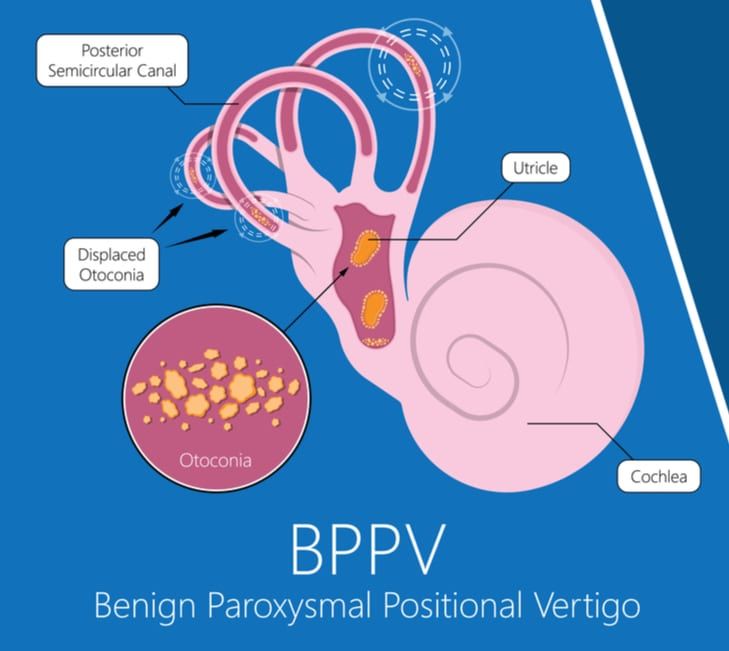For those of us who have experienced vertigo, we know how debilitating it can be. Dizziness, nausea, and a loss of balance can strike at seemingly any time. We wonder, “Why won’t the room stop spinning?” It may help to take a closer look at what vertigo is, it’s causes, and the different types of diagnoses that cause this twisted sensation.

Benign Paroxysmal Positional Vertigo (BPPV) is the most common cause of vertigo, and is the underlying cause for more than 20% of people experiencing general dizziness. BPPV is believed to be caused by the movement or displacement of small, calcium-bicarbonate crystals inside of our inner ears. These crystals then wind up in the semicircular canals, which are fluid filled tubes that can detect changes in our head position. The semicircular canals help our body understand it’s position in space and are vital in our bodies ability to balance. Although there are three semicircular canals in each ear, the posterior canal is the canal that is most typically affected.
The most common symptom of Vertigo is the feeling of the room spinning around you, most likely brought on by a rapid change in the position of your head (like rolling over too quickly, quickly turning your head to look above or behind you). This sensation of vertigo may also be accompanied by nausea, vomiting, difficulty with seeing or reading, and a loss of balance. If you experience these symptoms, your first stop should be your physical therapist!
Physical therapists are uniquely equipped to treat BPPV and the symptoms that arise during a bout with vertigo. Your therapist will assess and perform specific special tests and examinations to determine if the cause of your dizziness is BPPV. These tests may include the Dix-Hallpike Test and the Supine Roll Test, which help determine which semicircular canal is affected, and will drive the treatment decisions you and your therapist will make. A screening of your neck, balance, and general mobility may also be completed.
After the examination, your therapist may choose to perform the most common treatment techniques, which have been proven to effectively relieve BPPV symptoms. These techniques are the Modified Epley maneuver and the Semont maneuver. Although these techniques may briefly bring on your symptoms, they are the most effective treatment. Your therapist will also work with you on improving your balance, addressing impairments in your neck range of motion that may be contributing to your symptoms, and teaching you ways to perform the Modified Epley and Semont maneuvers at home, should your BPPV arise again in the future.

It is important for you to be seen by a physical therapist if you experience these symptoms. Your therapist will be able to determine if these symptoms are caused by BPPV, or other conditions, such as anxiety or panic attacks, migraine-induced dizziness, or Meniere’s disease (hearing loss and ringing in the ear). Thanks to direct access you DO NOT need to see you physician first for a prescription. Instead, you can opt to have your symptoms of vertigo treated acutely (CLICK HERE TO SCHEDULE AN APPOINTMENT). Having treatment in the earliest stages of vertigo will lead to the quickest time to feeling symptom free!
Patrick Maybury, DPT is a licensed physical therapist who attended Quinnipiac University, graduating with a Doctorate in Physical Therapy in 2017. Patrick is Level 2 Certified by the Institute of Advanced Musculoskeletal Treatment for Dry Needling and is a Certified Mulligan Practitioner. Patrick has taken advanced courses in spinal and extremity manipulation and Selective Functional Movement Assessment (SFMA). Patrick has extensive experience treating patients with varying orthopedic conditions, from weekend warriors to Division 1 athletes. Patrick’s wide variety of experience and skill set allows him to tailor treatments to the patient’s specific needs across the lifespan, ranging from pediatric patients to geriatric patients.
Tags:
- BPPV
- Branford
- Connecticut
- Crystals
- CT
- Ear
- Epley Manuever
- Hamden
- Milford
- New Haven
- physical therapy
- Physio
- PT
- The Room is Spinning
- Vertigo
- Vestibular
- Wallingford
- Woodbridge


